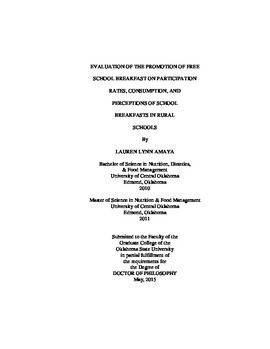| dc.description.abstract | Nationally, participation in School Breakfast Program (SBP) is much lower than National School Lunch Program, with research showing that barriers and stigmas associated with SBP have an influence on lower participation. Consuming breakfast may improve nutrient intakes, cognitive function, classroom behavior, and risk of overweight. The objectives of this study were to assess the effectiveness of universal free breakfast, breakfast in the classroom (BIC), and a small promotion on participation in and perceptions of SBP, and to assess the impact of BIC and grade-level on nutrient intakes in a rural school district in Oklahoma. Repeated measures ANOVA were used to compare differences in breakfast participation before and after implementation of universal free breakfast, BIC, grade level, and a breakfast promotion. There were 5987 students enrolled in school year 2012-2013, and 6047 students enrolled in 2013-2014. A convenience sample of 288 students participated in plate waste surveys at three schools at the beginning, middle, and end of school year 2013-2014 and analyses included ANOVA and Student's t-tests. All elementary and secondary students (n=747) and their parents (n-828) in the district were invited to provide their perceptions using online surveys at the beginning and end of school year 2013-2014 with Student's t-tests, ANOVA, and Chi-square analyses. Significantly higher breakfast participation rates were seen after implementation of universal free breakfast, and in elementary children, especially those participating in BIC. Students eligible for full-price meals had the greatest increase in participation. For consumption, although selection of most nutrients was higher in traditional breakfast, only consumption of total and saturated fat were higher in traditional breakfast and calcium consumption was higher for BIC. For perceptions, lower overall survey responses were found at the conclusion of the year, in elementary students who participated in BIC, and for older students and their parents. Targeting interventions on those groups with low SBP perceptions by addressing specific barriers and stigmas may have a positive impact on perceptions and in turn, increase participation in the program. In addition, by promoting healthy foods in SBP, districts may increase participation in SBP as well as improve nutrition of participating children. | |
